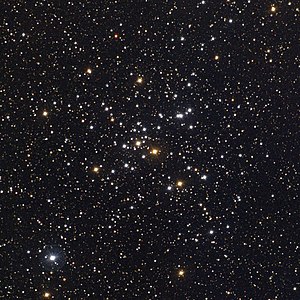Messier 41
| Messier 41 | |
|---|---|
 Open cluster Messier 41 in Canis Major | |
| Observation data (J2000 epoch) | |
| Right ascension | 06h 46.0m [1] |
| Declination | −20° 46′[1] |
| Distance | 2,300 ly[2] (710 pc) |
| Apparent magnitude (V) | 4.5[1] |
| Apparent dimensions (V) | 38 arcmin[2] |
| Physical characteristics | |
| Radius | 12.5 ly |
| Estimated age | 190 million yrs[3] |
| Other designations | M41,[1] NGC 2287[1] |
| Associations | |
| Constellation | Canis Major |
Messier 41 (also known as M41 or NGC 2287) is an open cluster in the constellation Canis Major. It is sometimes referred to as the Little Beehive Cluster.[4] It was discovered by Giovanni Batista Hodierna before 1654 and was perhaps known to Aristotle about 325 BC.[5] It lies about four degrees almost exactly south of Sirius, with which it forms a roughly equilateral triangle with Nu2 Canis Majoris to the west—all three figure in the same field in binoculars.[6]
The cluster covers an area about the size of the full Moon.[6] It contains about 100 stars, including several red giants the brightest of which has spectral type K3, apparent magnitude 6.3 and is near the center, and some white dwarfs.[7][8][9] The cluster is estimated to be moving away from us at 23.3 km/s.[1] The diameter of the cluster is 25–26 light-years (7.7–8.0 pc). It is estimated to be 190 million years old, and cluster properties and dynamics suggest a total life expectancy of 500 million years for this cluster, before it will have disintegrated.[3]
Walter Scott Houston describes the appearance of the cluster in small telescopes:[10]
Many visual observers speak of seeing curved lines of stars in M41. Although they seem inconspicuous on photographs, the curves stand out strongly in my 10-inch [reflecting telescope], and the bright red star near the center of the cluster is prominent.
The bright red/orange star near the center is HIP 32406, a giant star of spectral type K2, about 1500 ly away of magnitude 6.9.
Gallery[edit]
-
M41 in an 8" telescope
-
M41 finder chart
-
Open cluster M41 taken from a 12-inch Dobson telescope in Viña del Mar
See also[edit]
References[edit]
- ^ a b c d e f "M 41". SIMBAD. Centre de données astronomiques de Strasbourg. Retrieved 2006-12-21.
- ^ a b "Messier Object 41". SEDS. Retrieved 2009-12-10.
- ^ a b Stoyan, Ronald (2008). Atlas of the Messier Objects: Highlights of the Deep Sky. Cambridge University Press. p. 171. ISBN 9780521895545.
- ^ The Dog Star and the Little Beehive Cluster
- ^ M41 possibly recorded by Aristotle
- ^ a b Kambic, Bojan (2009). Viewing the Constellations with Binoculars: 250+ Wonderful Sky Objects to See and Explore. New York, New York: Springer. p. 230. ISBN 978-0-387-85355-0.
- ^ Koester, D. Reimers, D. (1981), "Spectroscopic identification of white dwarfs in Galactic Clusters I. NGC2287 and NGC3532", Astronomy & Astrophysics, 99, L8-11
- ^ De Laet, Rony (2011). The Casual Sky Observer's Guide: Stargazing with Binoculars and Small Telescopes. New York, New York: Springer. pp. 95–97. ISBN 978-1-4614-0595-5.
- ^ Dobbie, P, Day-Jones, A, Williams, K, Casewell, S, Burleigh, M, Lodieu, N, Parker, Q, Baxter, R, (2012), "Further investigation of white dwarfs in the open clusters NGC2287 and NGC3532", Monthly notices of the Royal Astronomical Society, 423, 2815–2828
- ^ Houston, Walter Scott (2005). Deep-Sky Wonders. Sky Publishing Corporation. ISBN 978-1-931559-23-2.
External links[edit]
- Messier 41 on WikiSky: DSS2, SDSS, GALEX, IRAS, Hydrogen α, X-Ray, Astrophoto, Sky Map, Articles and images
- Messier 41, SEDS Messier pages
- NightSkyInfo.com – M41
- M41 Hires LRGB CCD Image






